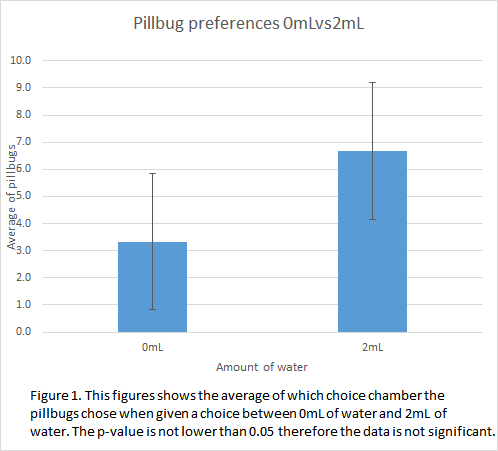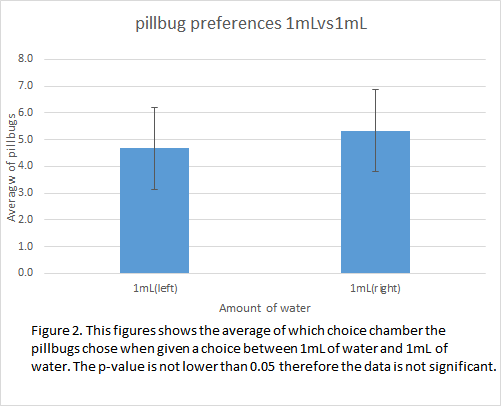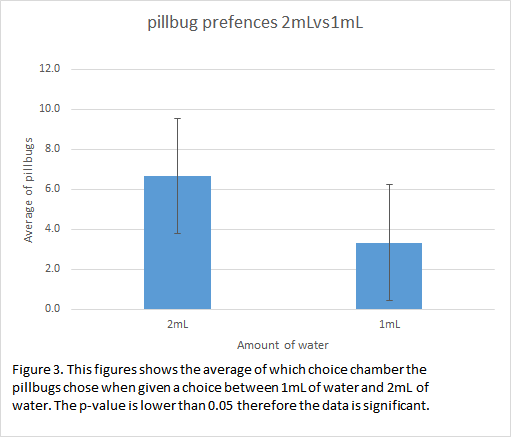Effect of Moisture Conditions on the Environmental Preference of Armadillidium Vulgare
| ✅ Paper Type: Free Essay | ✅ Subject: Biology |
| ✅ Wordcount: 1465 words | ✅ Published: 23 Sep 2019 |
The effect of moisture conditions on the environmental preference of armadillidium vulgare.
Abstract:
There were three different choice chambers with different amounts of water in each chamber. The armadillidiidae vulgare were placed in the choice chamber for a period of 10 minute. After each minute, the number of armadillidiidae vulgare on each side of the choice chamber was recorded. An average of 3.3 pillbugs stayed on the 0 mL side at the end of 10 minutes while 6.7 stayed on the 2 mL side. The results of the second experiment with 1 mL on each side of the choice chamber there was an average of 4.7 pill bugs on the left and 5.3 on the right. The third experiment with 2 mL and 1 mL shows an average of 6.7 pill bugs on the 2 mL side and 3.3 on the 1 mL side. This experiment shows that most pill bugs stayed on the side with more water. Thus pill bugs show a preference to moist and wet areas. These results can aid farmers and result in higher crop yields and lowers crop loss.
Introduction:
Pill Bugs can go by many different names: roly-poly, wood louse, armadillo bug, potato bug, but their scientific name is Armadillidium vulgare. They may seem like insects, but Armadillidium vulgare are terrestrial crustaceans. They are beneficial in the garden but can be pests indoors. Pill bugs can cause damage in certain agricultural systems, including areas with heavy rains and flood conditions. They cause unwanted damage to young crops and crop loss can be high. Through the combined analysis of a controlled feeding trial and field reports, we show A. vulgare is able to feed on and damage a range of pulses, legumes, cereals, and oilseeds, as emerging seedlings ( Douglas, Macfadyen, Hoffmann, Umina P,2017). Farmers will be able to prevent these unwanted pests from eating crops by creating an environment opposite to environments preferred by pillbugs.
The isopod, pill bugs are usually found underneath rocks, piles of decaying leaves, and tree bark. The diet of pill bugs is largely made up of decaying plants. Pill bugs will also eat living plants, especially in wet conditions, sometimes consuming leaves, stems, shoots, roots, tubers, and fruits (Wood, Schlindwein, Soares & Araujo, 2012).
Armadillidium vulgare are the only member of the crustacean that has has ability to roll into a ball. These crustaceans roll up into a ball for many reasons, such as to protect
their vulnerable organs (Smigel & Gibbs, 2008). Armadillidium vulgare breathe through gill-like structures (Smigel & Gibbs, 2008) .The purpose of this experiment is to explore if Armadillidium vulgare prefer dry or moist places. We hypothesized that Armadillidium vulgare are attracted tomoist places.
Methods:
This experiment was done to determine if Armadillidiidae vulgare prefer moist or dry places. There were three different choice chambers with different amounts of water in each chamber. The armadillidiidae vulgare were placed in the choice chamber for a period of 10 minute.
A total of 10 armadillidiidae vulgare were used on per experiment. Each choice chamber had a piece of paper towel and 5 armadillidiidae vulgare were placed on each side of the choice chamber. After each minute, the number of armadillidiidae vulgare on each side of the choice chamber was recorded. 0 mL of water and 2 mL of water were placed on two seperate paper towels using a dropping pipette. The armadillidiidae vulgare were placed and observed for 10 minutes.1 mL of water and 1 mL of water were placed on two seperate paper towels using a dropping pipette as our control group. 1 mL of water and 2 mL of water were placed on two seperate paper towels using a dropping pipette as another experimental group. Each experiment had 3 trials. Data was recorded each minute using a timer.
Results:
In this experiment, the preference of moisture level of pill bugs was collected. The data collected show that the means are not the same for each experiment. The first experiment with 0 mL of water and 2 mL of water demonstrate that an average of 3.3 pillbugs stayed on the 0 mL side at the end of 10 minutes while 6.7 stayed on the 2 mL side (Figure 1). The results of the second experiment with 1 mL on each side of the choice chamber there was an average of 4.7 pill bugs on the left and 5.3 on the right by the end of 10 minutes (Figure 2). The third experiment with 2 mL and 1 mL shows an average of 6.7 pill bugs on the 2 mL side and 3.3 on the 1 mL side at the end of 10 minutes (figure 3). The standard deviation of the means for each experiment was about the same. The the standard deviation for 0mL and 2 mL was 2.5 for both sides (Table 1). The standard deviation for 1 mL on both sides was 1.2 on the left side and 1.5 on the right side (Table 2). The standard deviation for 1 mL and 2 mL is 2.9 on both sides (Table 3). The p-values of the data for the 0 mL and 2 mL, and the 1 mL on both sides experiments was p>0.05, the differences between means was not significant (Table 4). The p-value for the 1 mL and 2 mL experiment was p<0.05, the difference in means was significant (Table 4).



|
Table 1. Summary data: Shown are the amount of pill bugs from the end of 10 minutes from every trial. The mean and standard deviation is also shown. |
|
Trial |
0 mL |
2 mL |
|
1 |
1 |
9 |
|
2 |
6 |
4 |
|
3 |
3 |
7 |
|
Mean |
3.3 |
6.7 |
|
Standard deviation |
2.5 |
2.5 |
|
Table 2. Summary Data: Shown are the amount of pill bugs from the end of 10 minutes from every trial. The mean and standard deviation is also shown. |
|
Trial |
1 mL (left) |
1 mL (right) |
|
1 |
3 |
7 |
|
2 |
5 |
5 |
|
3 |
6 |
4 |
|
Mean |
4.7 |
5.3 |
|
Standard deviation |
1.2 |
1.5 |
|
Table 3, Summary data: Shown are the amount of pill bugs from the end of 10 minutes from every trial. The mean and standard deviation is also shown. |
|
Trial |
1 mL |
2 mL |
|
1 |
10 |
0 |
|
2 |
5 |
5 |
|
3 |
5 |
5 |
|
Mean |
6.7 |
3.3 |
|
Standard deviation |
2.9 |
2.9 |
|
Table 4: This table shows the p-values of the data collected through a t-test |
|
comparison |
p-value |
|
0 mL/ 2 mL |
0.2 |
|
1mL(left)/ 1mL(right) |
0.6 |
|
1mL/ 2mL |
-0.2 |
Discussion:
The first experiment with 0 mL of water and 2 mL of water shows that on average 3.3 pillbugs stayed on the 0 mL side while 6.7 stayed on the 2 mL side (Figure 1). The results of the second experiment there was an average of 4.7 pill bugs on the left and 5.3 on the right sides of the choice chamber (Figure 2). The third experiment shows an average of 6.7 pill bugs on the 2 mL side and 3.3 on the 1 mL side (Figure 3). Mistakes could have been made due to the low number of trials. Additionally during the experiment, when we counted the amount of pillbugs there were sometimes pill bugs in the middle of the choice chamber.
This experiment shows that most pill bugs stayed on the side with more water. Thus pill bugs show a preference to moist and wet areas. This is helpful information because it can be used to create environments that can grow crops without pill bugs intruding. By creating drier areas, farmers can prevent pill bugs from inhabiting their farmland. Farmers have resorted to burning excess crop residues to manage populations of pill bugs around their crops (Johnson WA, Alfaress S, Whitworth RJ, McCornack BP. 2012).
In future experiments, more discoveries about the preferences of pill bugs’ habits could be made. One aspect that could be studied more about is the prefered temperature of an environment. Pill bugs also seem to live in areas with large amounts of crops or woodland, though forest fragmentation does not appear to affect their population (Tajovský K,Hošek J, Hofmeister J, Wytwer J.2012). Additionally by finding what crops pill bugs prefer, farmers could avoid crop loss by growing less of those crops. Special attention and care could also be placed on the crops endangered by pill bugs.
This experiment supports the null hypothesis that pill bugs prefer environments that are wet and moist. The data was significant and the p-value was lower than 0.05. Our results indicate that pill bugs generally prefer a wetter environment. These results can aid farmers and result in higher crop yields and lowers crop loss.
References:
- Douglas J, Macfadyen S, Hoffmann A, Umina P.(2017).Crop seedling susceptibility to Armadillidium vulgare (Isopoda: Armadillidiidae) and Ommatoiulus moreletii (Diplopoda: Iulidae). Journal of Economic Entomology.110(6): 2679–2685
- Johnson WA, Alfaress S, Whitworth RJ, McCornack BP.(2012).Crop residue and residue management effects on Armadillidium vulgare (Isopoda: Armadillidiidae) populations and soybean stand densities.J Econ Entomol.105(5):1629-39.
- Smigel, J. T., & Gibbs, A. G. (2008). Conglobation in the pill bug, Armadillidium vulgare, as a water conservation mechanism. Journal of insect science (Online), 8, 1-9.
- Tajovský K,Hošek J, Hofmeister J, Wytwer J.(2012). Assemblages of terrestrial isopods (Isopoda, Oniscidea) in a fragmented forest landscape in Central Europe. Zookeys. (176):189-98
- Wood, C., Schlindwein, C. C. D., Soares, G. L. G., & Araujo, P. B. (2012). Feeding rates of Balloniscus sellowii (Crustacea, Isopoda, Oniscidea): the effect of leaf litter decomposition and its relation to the phenolic and flavonoid content. ZooKeys. doi:10.3897/zookeys.176.1940
Cite This Work
To export a reference to this article please select a referencing stye below:
Related Services
View allDMCA / Removal Request
If you are the original writer of this essay and no longer wish to have your work published on UKEssays.com then please click the following link to email our support team:
Request essay removal


